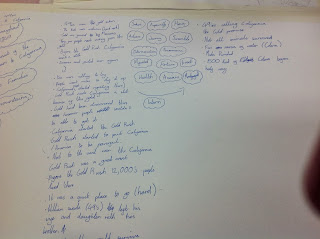First of all, apologies for taking so long to re-engage with my blog this term. It has been the usual very busy but energetic start to the year in our Outstanding school and 4 weeks in, there is much to celebrate. I conducted a Learning Walk this week and observed some inspirational practice. One thing I did see which fascinated me, was the way that the children in year 5/6 had been given the freedom to record their research taken from several film clips of the Gold Rush, on the table itself! Miss Hinton took the plunge to attach permanent rolls of white paper onto the desks and encouraged the children to record their findings in whichever way they chose. I found it very interesting to see the number of different ways children chose to lay out their writing.
This sense of ownership, freedom and flexibility to direct their own learning, undoubtedly raised the engagement of the children. It gave them a chance to tailor-make their notes to suit their own learning style; some pieces of info were linear, some almost like a flow chart, some pieces were set out in bubbles. Without prescribing the way it had to be set out, the children chose ways which made more sense to them. Interestingly also, despite these notes being the "rough" copy of their writing, the presentation and quality of handwriting was incredible- I wonder if this is because they wanted their "creation" to be fabulous; the heightened sense of ownership compelling them to take an increased pride in what they were doing?
I was also struck by the quality subject specific language that the children had identified and copied down ready to apply to their own compositions. The key to success here is ensuring that the high level vocabulary is used in the correct context and is highly fit for purpose. I can't wait to see the finished pieces.

Observe the quality of the language, which will be applied to the children's own compositions.
Subject specific vocab is expertly drawn out by the children




